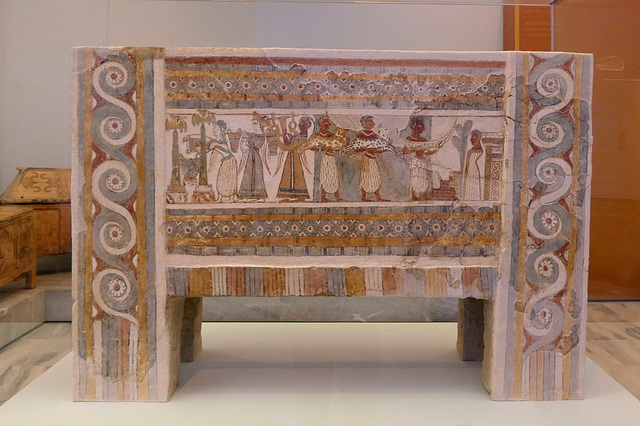Location
Lat, Lng: 35.339135, 25.137225
You can copy the above to your favourite mapping app.
Address: Ceratonia
You can copy the above to your favourite mapping app.
Address: Ceratonia
See also...
Keywords
Authorizations, license
-
Visible by: Everyone -
All rights reserved
-
7 visits
Heraklion - Archaeological Museum


Crete, the largest and most populous of the Greek islands, is located about 100 km south of the Peloponnese. Crete was the center of Europe's first advanced civilization, the Minoans, from 3000 to 1400 BC. The Minoan civilization was overrun by the Mycenaean civilization from mainland Greece. Crete was later ruled by Rome, then successively by the Byzantine Empire, Andalusian Arabs, the Byzantine Empire again, the Venetian Republic, and the Ottoman Empire. In 1898 Crete, whose people had for some time wanted to join the Greek state, achieved independence from the Ottomans, formally becoming the Cretan State. Crete became part of Greece in December 1913.
Heraklion is the largest city and the administrative capital of the island of Crete. With a municipal population of about 180.000 it is the fourth largest city in Greece. The greater area of Heraklion has been continuously inhabited since at least 7000 BCE, making it one of the oldest inhabited regions in Europe. As a major center of the Minoan civilization it often considered Europe's oldest city.
The Heraklion Archaeological Museum is one of the largest museums in Greeceand the best in the world for Minoan art, as it contains by far the most important and complete collection of artefacts of the Minoan civilization of Crete.
The museum began in 1883 as a simple collection of antiquities; it was about the time when the Minoan civilization was beginning to be rediscovered, and shortly before the first excavations using proper scientific methods. It was also during the period when Crete was a virtually autonomous part of the Ottoman Empire, after the Pact of Halepa of 1878, later followed by the independent Cretan State (1898-1913). The political situation helped to keep Cretan finds on the island during a crucial period of discoveries.
The museum is located in the town centre. It was built between 1937 and 1940 on a site previously occupied by the Roman Catholic monastery of Saint-Francis which was destroyed by earthquake in 1856.
Hagia Triada Sarcophagus
The sarcophagus of Agia Triada is a stuccoed limestone coffin painted with frescoes on the outside. It was found at the beginning of the 20th century in a chamber tomb north-east of the excavation site of the palace of Agia Triada. The sarcophagus is generally dated to around 1370 to 1300 BC
Clay sarcophagi play an important part in the Minoan sepulcral culture, the Agia Triada sarcophagus is the only stone sarcophagus ever found on Crete. It is assumed that the tomb in which it was found originally served as the burial place of a prince during the years of Mycenaean rule on Crete.
Heraklion is the largest city and the administrative capital of the island of Crete. With a municipal population of about 180.000 it is the fourth largest city in Greece. The greater area of Heraklion has been continuously inhabited since at least 7000 BCE, making it one of the oldest inhabited regions in Europe. As a major center of the Minoan civilization it often considered Europe's oldest city.
The Heraklion Archaeological Museum is one of the largest museums in Greeceand the best in the world for Minoan art, as it contains by far the most important and complete collection of artefacts of the Minoan civilization of Crete.
The museum began in 1883 as a simple collection of antiquities; it was about the time when the Minoan civilization was beginning to be rediscovered, and shortly before the first excavations using proper scientific methods. It was also during the period when Crete was a virtually autonomous part of the Ottoman Empire, after the Pact of Halepa of 1878, later followed by the independent Cretan State (1898-1913). The political situation helped to keep Cretan finds on the island during a crucial period of discoveries.
The museum is located in the town centre. It was built between 1937 and 1940 on a site previously occupied by the Roman Catholic monastery of Saint-Francis which was destroyed by earthquake in 1856.
Hagia Triada Sarcophagus
The sarcophagus of Agia Triada is a stuccoed limestone coffin painted with frescoes on the outside. It was found at the beginning of the 20th century in a chamber tomb north-east of the excavation site of the palace of Agia Triada. The sarcophagus is generally dated to around 1370 to 1300 BC
Clay sarcophagi play an important part in the Minoan sepulcral culture, the Agia Triada sarcophagus is the only stone sarcophagus ever found on Crete. It is assumed that the tomb in which it was found originally served as the burial place of a prince during the years of Mycenaean rule on Crete.
- Keyboard shortcuts:
Jump to top
RSS feed- Latest comments - Subscribe to the comment feeds of this photo
- ipernity © 2007-2025
- Help & Contact
|
Club news
|
About ipernity
|
History |
ipernity Club & Prices |
Guide of good conduct
Donate | Group guidelines | Privacy policy | Terms of use | Statutes | In memoria -
Facebook
Twitter











Sign-in to write a comment.